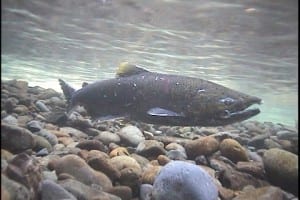 Careful planning, quick thinking and coordination with the Army Corps of Engineers prevented major flooding and salmon egg losses on the Skagit River after a massive Thanksgiving week storm dumped nearly 11 inches of rain near City Light’s dams.
Careful planning, quick thinking and coordination with the Army Corps of Engineers prevented major flooding and salmon egg losses on the Skagit River after a massive Thanksgiving week storm dumped nearly 11 inches of rain near City Light’s dams.

Summer Chinook salmon spawn in the Skagit river from August through October each year. Managing river flows during heavy November rains protected the eggs those fish laid from being washed away. — Photo by Dave Bickford, courtesty of U.S. Forest Service
Careful planning, quick thinking and coordination with the U.S. Army Corps of Engineers prevented major flooding and salmon egg losses on the Skagit River after a massive Thanksgiving week storm dumped nearly 11 inches of rain near City Light’s dams.
On Nov. 24, the National Weather Service forecasted a significant rain storm for the Skagit basin, similar in scope to storms in 1990 and 1995 that caused major floods downstream. In preparation, City Light power marketing and operations lowered the levels at Gorge and Diablo lakes to make room and reduce spill, and stopped generation at the Ross Powerhouse.
On Nov. 27, a day after the rains started, river flows at Concrete exceeded 90,000 cubic feet per second – about six times the average flow at that location. At that point, the Army Corps of Engineers took control of the City Light dams.
From Nov. 24 to 29, 10.87 inches of rain fell at the Diablo Powerhouse, raising Ross Lake 6.71 feet. On Nov. 29, the Army Corp of Engineers released control of the Skagit project back to Seattle, as Concrete flows decreased below 80,000 cfs.
Despite the heavy rain and spills into the lower river, we were able to minimize flooding downstream, with only a 48-hour period when high river flows could scour Chinook and chum salmon redds. This was the direct result of lowering of lake levels ahead of the storm, an action that was planned early in the season in cooperation with the Skagit Flow Plan Coordinating Committee, a review board comprised of state, tribal, and federal fisheries resource agencies.